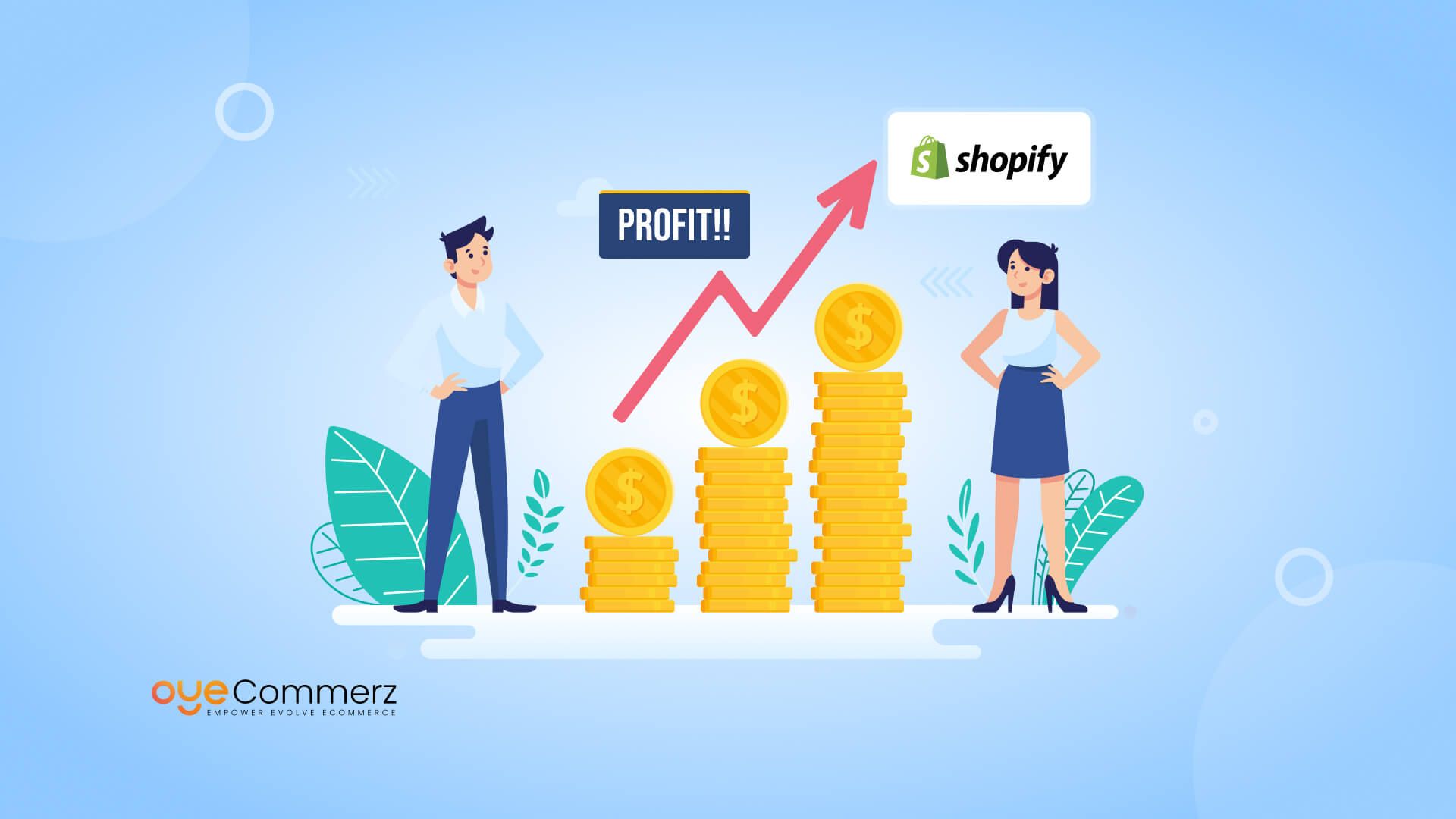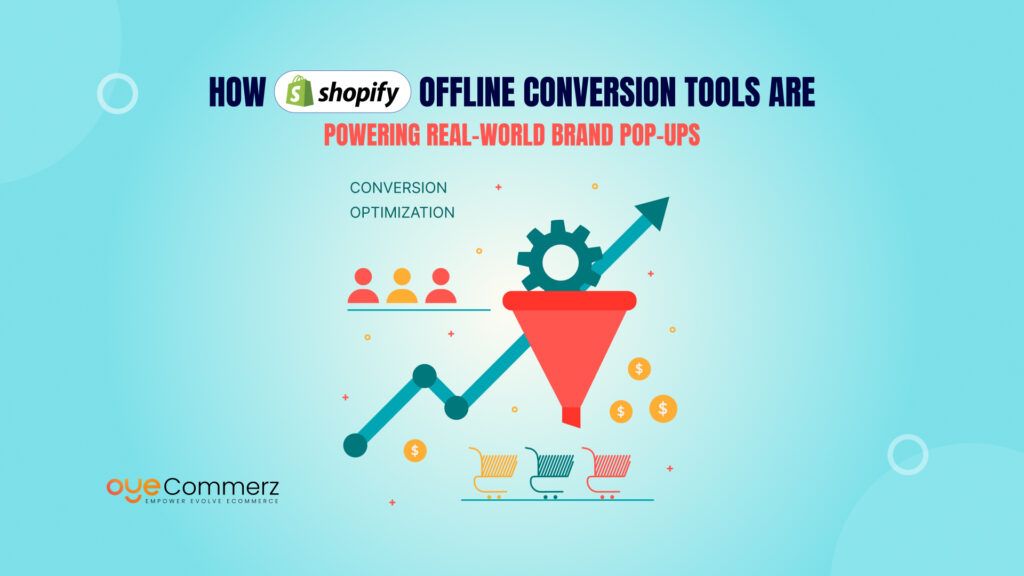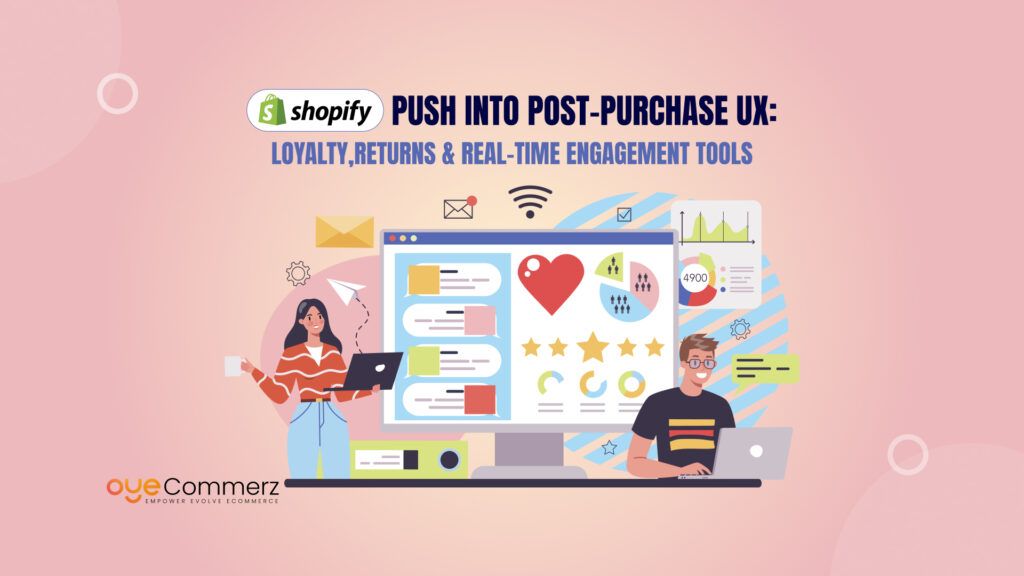Is your current e-commerce platform holding your business back? In today’s digital marketplace, the foundation of your online store plays a pivotal role in determining your success. A well-chosen e-commerce platform does more than just host your products; it drives growth, enhances customer experience, and scales with your ambitions.
Enter Shopify, a platform designed to transform how businesses operate online. With its unmatched scalability, seamless performance, and robust profitability tools, Shopify empowers merchants to create thriving, future-ready stores.
This blog explores why migrating to Shopify is a smart move for businesses seeking to unlock their full potential. Whether you’re frustrated with limitations, aiming to optimize operations, or striving for growth, Shopify offers the tools and flexibility to elevate your brand from just a platform to a true profit engine.
Table of Contents
ToggleHow E-commerce Companies Earn Profit?
E-commerce companies leverage a combination of strategies to optimize their revenue streams, reduce costs, enhance customer retention, and make data-driven decisions. Here’s how these elements contribute to profitability in detail:
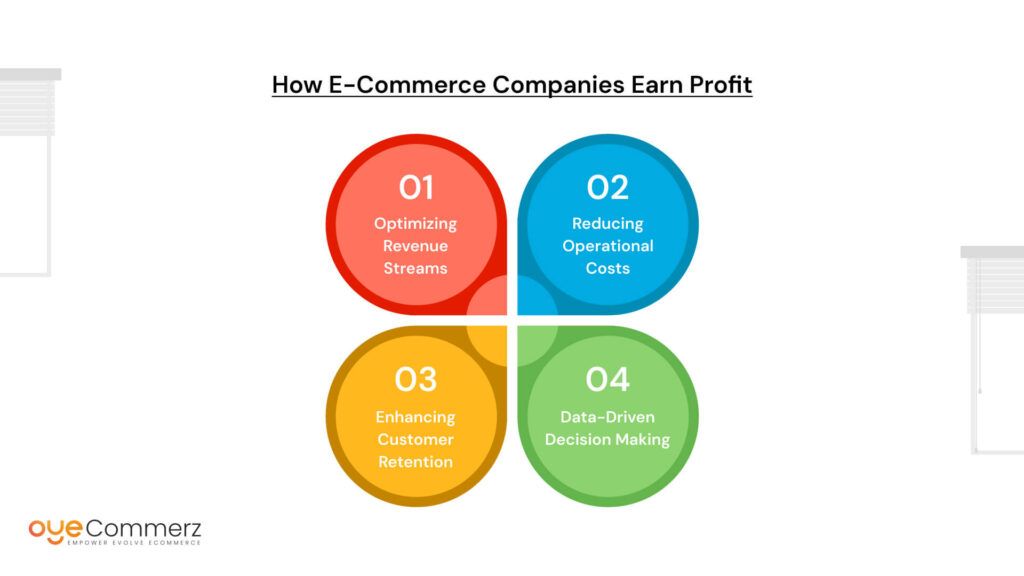
1. Optimizing Revenue Streams
To maximize revenue, e-commerce companies diversify their income sources and implement strategic selling techniques:
- Multiple Sales Channels:
E-commerce businesses no longer rely solely on their online store. They expand by integrating with:- Social media platforms (e.g., Instagram, Facebook, TikTok) to target new audiences.
- Online marketplaces like Amazon, eBay, and Walmart for increased visibility.
- In-person selling options through point-of-sale (POS) systems.
This omnichannel approach helps tap into diverse customer bases and ensures steady revenue from multiple sources.
- Upselling and Cross-Selling Strategies:
- Upselling involves encouraging customers to purchase a higher-end product than they originally intended. For instance, showcasing a premium version of a product with better features.
- Cross-Selling suggests complementary products, such as offering a laptop sleeve or accessories when a customer buys a laptop.
These strategies increase the average order value (AOV) and boost overall profitability.
2. Reducing Operational Costs
Minimizing expenses is critical for boosting profit margins, and e-commerce companies achieve this through:
- Automation of Processes:
- Tools like automated inventory management reduce the need for manual intervention by tracking stock levels, reordering products, and preventing overstocking.
- Automated shipping solutions calculate rates, generate labels, and notify customers, reducing operational delays.
- Cloud-Based Platforms:
- Hosting a store on platforms like Shopify eliminates the need for expensive server infrastructure.
- Cloud solutions scale as the business grows, avoiding large upfront investments and reducing IT maintenance costs.
These cost-effective solutions free up resources that can be redirected to revenue-generating activities.
3. Enhancing Customer Retention
Acquiring new customers can be costly, so retaining existing ones is a priority for long-term profitability:
- Personalized Shopping Experiences:
- Using customer data, e-commerce businesses offer tailored product recommendations, dynamic pricing, and targeted email campaigns.
- Personalization increases customer satisfaction, making them more likely to return and make repeat purchases.
- Loyalty Programs and Repeat Purchases:
- Programs that reward points, discounts, or perks for frequent purchases incentivize customers to stay loyal.
- Features like subscription models (e.g., for recurring needs like pet supplies) encourage customers to commit to long-term purchasing relationships.
4. Data-Driven Decision Making
Analyzing data allows e-commerce companies to refine their strategies and maximize profitability:
- Using Insights for Pricing:
- Tracking market trends, competitor pricing, and customer behavior enables dynamic pricing models that optimize sales.
- For instance, offering discounts during high-demand seasons to increase volume while maintaining profitability.
- Adjusting Promotions:
- By analyzing which promotions generate the most revenue, businesses can focus on those that resonate with their audience.
- Retargeting campaigns remind customers of abandoned carts or previous interests, boosting conversion rates.
- Refining Product Offerings:
- Sales data helps identify best-selling products and slow-moving inventory.
- Businesses can discontinue underperforming items, reinvest in top sellers, and explore complementary product categories.
The Challenges of Outdated or Restrictive Platforms
Many e-commerce businesses face hurdles when operating on outdated or restrictive platforms. These limitations not only affect day-to-day operations but also have a long-term impact on profitability and growth. Here’s a detailed look at the challenges:
1. Common Issues with Older or Restrictive Platforms
- High Maintenance Costs:
- Older platforms often require frequent updates, custom coding, and troubleshooting, leading to significant operational expenses.
- Businesses may need to rely on specialized developers to maintain their site, increasing costs and delaying improvements.
- Hidden fees for hosting, security patches, and third-party tools add to the financial burden.
- Limited Scalability:
- As businesses grow, restrictive platforms struggle to handle increased traffic and larger inventories.
- Performance bottlenecks, such as slow loading times and frequent crashes during peak seasons, are common.
- Adding new features or integrations becomes complex and expensive, limiting the ability to adapt to market trends.
- Poor User Experience:
- Outdated platforms often lack modern design options, resulting in clunky, unattractive interfaces.
- Limited mobile optimization leads to poor experiences for smartphone users, which can significantly affect conversions.
- Complicated checkout processes, broken links, or slow page speeds frustrate customers and lead to abandoned carts.
2. Impact of These Challenges on Business Profitability and Growth
- Reduced Customer Satisfaction:
- A poor user experience drives potential customers away, reducing conversion rates and revenue.
- Dissatisfied customers are less likely to return, leading to a higher churn rate and a need for more expensive customer acquisition efforts.
- Missed Growth Opportunities:
- Businesses stuck on restrictive platforms often lack access to modern tools like advanced marketing features, analytics, or omnichannel capabilities.
- This makes it harder to expand into new markets or adopt innovative strategies like personalization, automation, or global selling.
- Increased Competition Pressure:
- Competitors using modern platforms like Shopify have access to better technology, faster performance, and superior customer engagement tools, giving them a competitive edge.
- Businesses on older platforms risk falling behind and losing market share.
- Higher Operational Strain:
- Time and resources spent on troubleshooting and maintaining the platform distract from core business activities like marketing and product development.
- Operational inefficiencies result in delayed order fulfillment, inaccurate inventory tracking, and other costly mistakes.
3. Why Sticking to a Suboptimal Platform May Hold Your Business Back
- Lack of Future-Proofing:
- Outdated platforms often fail to keep pace with industry trends, making it harder for businesses to adapt to changing customer expectations.
- For example, lacking support for mobile-first designs, voice search, or AI-driven personalization can alienate modern shoppers.
- Difficulty Integrating with New Tools:
- Many older platforms don’t easily integrate with third-party tools or emerging technologies like payment gateways, CRM systems, or marketing automation software.
- This limits the ability to innovate and streamline operations.
- Capped Revenue Potential:
- Without the ability to scale efficiently, businesses reach a growth ceiling.
- Performance issues during high-traffic events like sales or product launches result in lost revenue and damage to brand reputation.
- Brand Perception:
- A website that looks outdated or performs poorly sends a message that the brand is not keeping up with the times.
- This can erode trust and deter both new and returning customers.
By recognizing the limitations of older or restrictive platforms, businesses can make informed decisions to migrate to more advanced solutions like Shopify, which are built to support growth, scalability, and exceptional user experiences.
What Makes Shopify a Game-Changer?
Shopify has emerged as a leading e-commerce platform because of its ability to address the challenges faced by businesses on outdated platforms. Its innovative features make it a powerful, flexible, and reliable choice for merchants looking to scale their businesses effectively. Let’s dive deeper into the key aspects that make Shopify a game-changer:
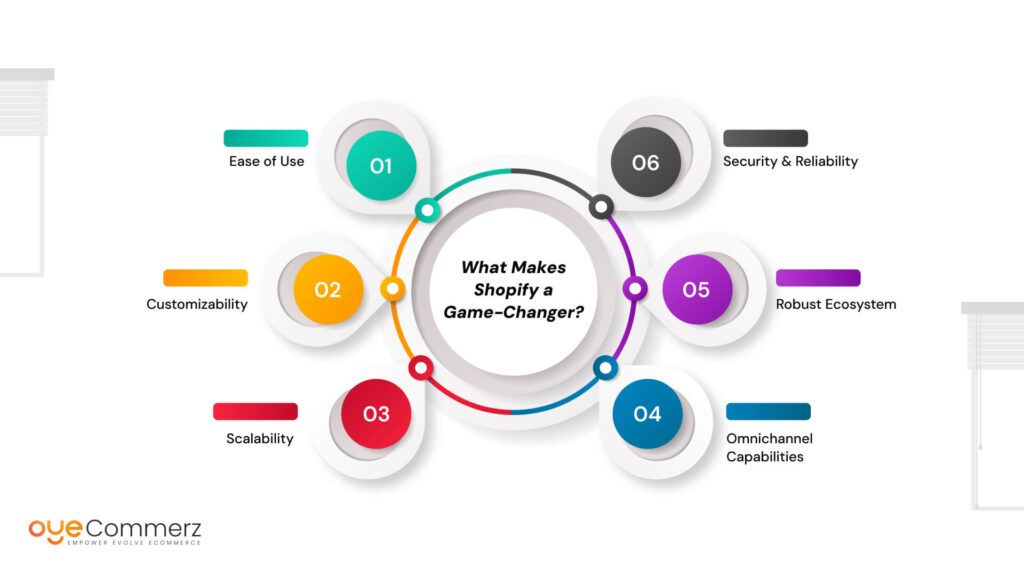
1. Ease of Use
Shopify is designed for simplicity, making it accessible even to users with minimal technical expertise.
- Merchant-Friendly Interface:
- The dashboard is intuitive, allowing merchants to manage inventory, orders, and customers easily.
- Drag-and-drop tools simplify store setup, enabling quick customizations without the need for coding.
- Customer Experience:
- Shopify stores are optimized for smooth navigation, ensuring customers can find products, add them to their cart, and checkout without friction.
- Mobile-responsive designs cater to the increasing number of shoppers using smartphones.
2. Customizability
Shopify offers a wide range of themes and apps to personalize your store and enhance functionality.
- Themes:
- Over 100 professionally designed themes, both free and premium, to match your brand identity.
- Themes are mobile-friendly and customizable, allowing you to tweak layouts, fonts, and colors.
- Apps:
- Access to over 8,000 apps on the Shopify App Store.
- These apps provide additional features like customer reviews, loyalty programs, email marketing, and SEO tools.
- Customization enables businesses to create unique, branded shopping experiences that set them apart from competitors.
3. Scalability
Shopify is built to grow with your business, whether you’re a small startup or a large enterprise.
- Handles High Traffic:
- Shopify can handle surges in traffic, such as during Black Friday sales, without crashing or slowing down.
- Expanding Product Catalogs:
- Easily manage thousands of products and variations without compromising store performance.
- Shopify Plus:
- For enterprise-level businesses, Shopify Plus offers advanced features like automation, custom checkout, and dedicated support.
4. Omnichannel Capabilities
Shopify makes it easy to sell across multiple platforms, reaching customers wherever they shop.
- Social Media Integration:
- Seamlessly connect with Facebook, Instagram, TikTok, and Pinterest to sell directly through these platforms.
- Marketplaces:
- Integrate with Amazon, eBay, and Walmart to expand your reach.
- In-Person Selling:
- Use Shopify’s POS system to sell products in physical locations while keeping inventory synced with your online store.
- This omnichannel approach ensures a consistent shopping experience across all touchpoints.
5. Robust Ecosystem
Shopify’s ecosystem is designed to support every aspect of e-commerce:
- Tools and Plugins:
- From analytics tools to marketing automation and payment gateways, Shopify offers integrations to simplify operations.
- Third-Party Support:
- Partner with developers, agencies, and Shopify Experts to customize and optimize your store further.
- Developer-Friendly:
- Access to APIs allows advanced customizations and integrations with other business tools like CRM and ERP systems.
6. Security & Reliability
Shopify prioritizes security to protect both merchants and customers.
- Built-In Security Features:
- Level 1 PCI DSS compliance ensures all transactions are secure.
- Free SSL certificates encrypt data and boost customer trust.
- Hosting Reliability:
- Shopify provides cloud-based hosting with 99.9% uptime, ensuring your store is always online.
- Automatic backups and updates reduce the risk of data loss or downtime.
- Merchants can focus on growing their business without worrying about technical vulnerabilities or server maintenance.
By combining ease of use, robust customization options, scalability, omnichannel capabilities, a rich ecosystem, and top-tier security, Shopify empowers businesses to thrive in a competitive e-commerce landscape.
The Business Benefits of Migrating to Shopify
Migrating to Shopify unlocks a wealth of benefits for e-commerce businesses, allowing them to operate more efficiently, provide better customer experiences, and achieve higher profitability. Here’s a detailed look at how Shopify empowers businesses to thrive:
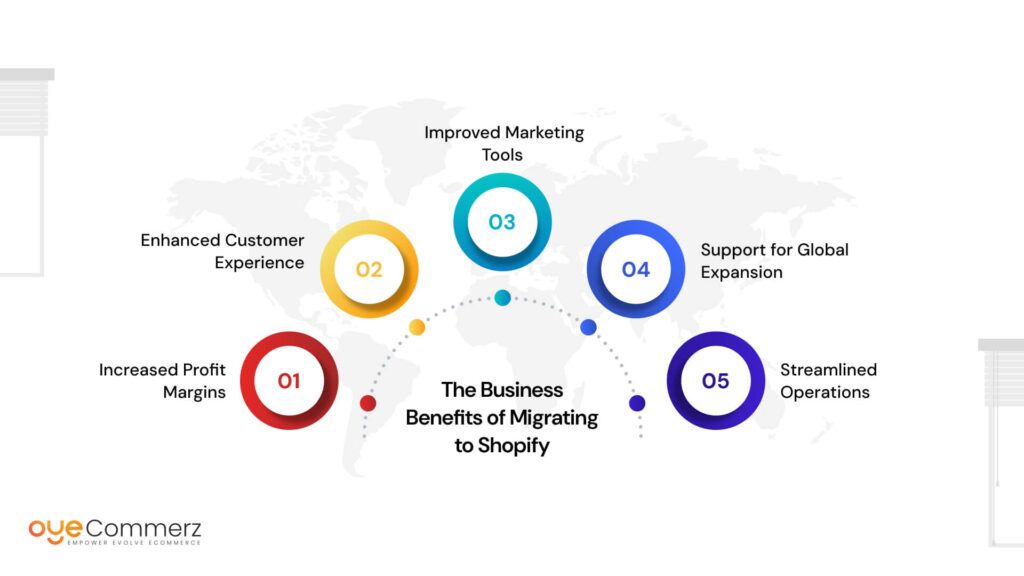
1. Increased Profit Margins
Shopify helps reduce operational costs and boost revenue through:
- Lower Maintenance Costs:
- Shopify’s cloud-based platform eliminates the need for expensive server hosting and IT maintenance.
- Automatic updates ensure your store stays secure and up-to-date without incurring additional costs.
- No hidden fees for essential features like hosting, security, or scalability.
- Competitive Pricing Models:
- Shopify offers flexible pricing plans suitable for businesses of all sizes, allowing merchants to pick the one that aligns with their budget and growth goals.
- Transparent pricing ensures businesses can forecast expenses more accurately.
2. Enhanced Customer Experience
A smooth and user-friendly shopping experience directly impacts conversions and customer satisfaction:
- Faster Loading Times:
- Shopify’s global content delivery network (CDN) ensures fast page speeds, reducing bounce rates and improving user engagement.
- Faster stores rank better on search engines, attracting more organic traffic.
- Smoother Checkout Processes:
- Shopify’s optimized checkout process supports multiple payment gateways, including one-click payment options like Shop Pay.
- Integrated features like auto-filling customer details and mobile-friendly checkout reduce cart abandonment.
- Responsive Design:
- Shopify themes are mobile-optimized, ensuring a seamless experience across devices.
3. Improved Marketing Tools
Shopify comes with built-in tools to enhance visibility, engage customers, and drive sales:
- Built-In SEO:
- Shopify provides SEO-friendly features such as customizable meta tags, clean URL structures, and automatic sitemap generation.
- Fast loading times and mobile responsiveness further boost your site’s search engine rankings.
- Email Marketing:
- Shopify Email allows merchants to create and send branded email campaigns directly from the platform.
- Easy segmentation ensures personalized communication with customers based on behavior, preferences, or purchase history.
- Analytics Features:
- Shopify’s dashboard provides real-time insights into sales, traffic, and customer behavior.
- Integration with tools like Google Analytics and Facebook Pixel allows deeper performance analysis.
4. Support for Global Expansion
Shopify makes it easy for businesses to enter international markets and cater to global audiences:
- Multi-Language Support:
- Shopify’s multi-language capabilities let businesses offer localized versions of their store to cater to customers in different regions.
- Apps like Shopify Translate & Adapt simplify the process of translating product pages and marketing content.
- Multi-Currency Options:
- Shopify Payments supports multiple currencies, enabling customers to shop in their local currency.
- Dynamic currency conversion helps build trust and encourages conversions from international shoppers.
- Tax and Shipping Calculations:
- Automated tax and shipping rate calculations streamline cross-border transactions.
5. Streamlined Operations
By automating processes and integrating essential business functions, Shopify reduces operational inefficiencies:
- Automation of Business Processes:
- Features like Shopify Flow (available on Shopify Plus) automate tasks such as inventory updates, customer tagging, and order notifications.
- Automated email sequences and abandoned cart recovery tools help retain potential customers without manual intervention.
- Integration with Third-Party Tools:
- Shopify integrates seamlessly with CRM systems, inventory management software, and shipping solutions to centralize operations.
- Apps for accounting (e.g., QuickBooks) and customer support (e.g., Zendesk) streamline backend workflows.
- Inventory Management:
- Real-time inventory tracking reduces errors, prevents overstocking or stockouts, and keeps operations running smoothly.
Migrating to Shopify empowers businesses to save time, reduce costs, and deliver superior customer experiences all of which contribute to sustainable growth and profitability.
How to Seamlessly Migrate to Shopify
Migrating to Shopify is a transformative process, but it requires careful planning and execution to ensure a smooth transition. Here’s a detailed breakdown of the key steps involved in a successful Shopify migration:
1. Preparation
Proper preparation sets the foundation for a seamless migration:
- Conducting Platform Analysis:
- Assess the limitations of your current platform, such as performance bottlenecks, high maintenance costs, or lack of features.
- Identify which data, design elements, and functionalities need to be preserved or enhanced.
- Document all integrations, customizations, and essential third-party tools to ensure compatibility with Shopify.
- Defining Migration Goals:
- Determine specific objectives, such as improving site speed, enhancing user experience, or integrating better marketing tools.
- Set measurable KPIs, like increasing conversion rates, reducing cart abandonment, or expanding to global markets.
- Create a timeline for the migration process, including key milestones and a launch date.
2. Data Migration
Transferring critical data securely and accurately is one of the most crucial aspects of the migration process:
- Products and Categories:
- Export product data, including titles, descriptions, prices, images, SKUs, and variants.
- Reorganize categories to align with Shopify’s collection structure, if needed, for better navigation.
- Customer Information:
- Migrate customer data, such as names, email addresses, and purchase history, to ensure a personalized shopping experience.
- Ensure GDPR compliance or other regional data protection standards during the migration.
- Order History:
- Transfer order records to maintain a complete transaction history for reporting and customer support purposes.
- Secure Migration:
- Use reliable migration tools or services to transfer data without errors or loss.
- Backup all data before starting the migration process to prevent disruptions.
3. Design & Functionality
Recreating or enhancing your store’s design and features is an opportunity to improve user experience:
- Recreating Your Store’s Look:
- Select a Shopify theme that closely matches or improves upon your current design.
- Customize the theme to align with your branding, including colors, fonts, and layout.
- Optimize for mobile responsiveness to cater to mobile shoppers.
- Enhancing Functionality:
- Integrate Shopify apps to add new features, such as customer reviews, upselling tools, or advanced search functionality.
- Use Shopify’s built-in tools for SEO, email marketing, and analytics to replace or enhance existing functionalities.
- Third-Party Integrations:
- Reconnect essential tools like payment gateways, shipping solutions, and CRM systems.
- Consider upgrading to Shopify Plus for access to advanced features like customizable checkout and Shopify Flow automation.
4. Testing & Optimization
Before going live, it’s essential to thoroughly test and optimize your Shopify store:
- Testing Features and Functionality:
- Test all site features, including navigation, product pages, search functionality, and the checkout process.
- Ensure that integrations, like payment gateways and shipping calculators, work seamlessly.
- Data Accuracy:
- Verify that all product information, customer data, and order history have been transferred accurately.
- Check for any broken links or missing assets, such as images or files.
- Performance Optimization:
- Test site speed and responsiveness across devices to ensure fast loading times.
- Review SEO settings, such as meta tags, redirects, and sitemap generation, to preserve search engine rankings.
- Soft Launch:
- Conduct a soft launch to a small group of customers or team members to gather feedback and identify potential issues.
5. Importance of Choosing the Right Migration Partner
Partnering with an experienced migration expert ensures a hassle-free transition:
- Technical Expertise:
- Professionals have the skills to handle complex migrations, including custom functionalities, large datasets, and third-party integrations.
- Minimized Downtime:
- A reliable migration partner ensures the process is completed quickly and efficiently, reducing the risk of downtime.
- Customized Solutions:
- Migration experts can tailor your Shopify store to meet your business needs, from design to advanced features.
- Post-Migration Support:
- A good partner provides ongoing support to resolve any post-launch issues and optimize your store for maximum performance.
By following these steps and leveraging the expertise of a trusted migration partner, businesses can seamlessly transition to Shopify while minimizing disruptions and maximizing the benefits of the new platform.
Why Oyecommerz is the Right Choice for Your Shopify Migration?
Choosing the right partner for your Shopify migration is critical to ensuring a smooth, efficient, and successful transition. Oyecommerz stands out as a leading expert in Shopify migrations, offering tailored solutions and proven results. Here’s why Oyecommerz is the ideal choice:
1. Expertise in Seamless Migrations
Oyecommerz has extensive experience in handling complex e-commerce migrations across various platforms, including Magento, WordPress, WooCommerce, and custom-built stores:
- Comprehensive Migration Process:
- From data transfer and design recreation to testing and optimization, Oyecommerz manages every aspect of the migration process.
- Their team ensures that your store’s data, functionality, and design are preserved or enhanced during the transition.
- In-Depth Shopify Knowledge:
- As Shopify experts, Oyecommerz is well-versed in the platform’s capabilities, enabling them to leverage Shopify’s features to maximize your store’s performance and scalability.
2. Experience and Customer Success Stories
Oyecommerz’s track record of successful Shopify migrations speaks for itself:
- Diverse Client Portfolio:
- Oyecommerz has worked with businesses of all sizes, from startups to established enterprises, across various industries.
- Their experience allows them to understand and address unique challenges specific to different business models.
- Proven Results:
- Clients have reported increased sales, better site performance, and improved customer satisfaction post-migration.
- Success stories highlight their ability to deliver customized solutions that drive tangible growth.
3. Tailored Migration Solutions
Oyecommerz understands that every business is unique, and their migration services reflect this:
- Customized Store Designs:
- They recreate or enhance your store’s design to align with your brand identity, ensuring a modern, user-friendly experience.
- For businesses looking to refresh their image, Oyecommerz offers creative redesign services to improve customer engagement.
- Feature Integration:
- They identify and implement the best Shopify apps and tools to meet your specific business needs, from advanced analytics to loyalty programs.
- Integration of third-party tools like CRMs, ERPs, and marketing platforms ensures seamless operations.
- Data Security and Accuracy:
- With meticulous attention to detail, Oyecommerz ensures the secure transfer of products, customers, and orders without errors or data loss.
4. Commitment to Zero Downtime
Oyecommerz prioritizes business continuity, ensuring that your operations are not disrupted during the migration process:
- Pre-Migration Testing:
- Thorough planning and testing ensure the new Shopify store is fully functional before launch.
- Staggered Rollouts:
- For larger migrations, they implement phased rollouts to minimize risks and ensure smooth transitions.
- Post-Migration Monitoring:
- Oyecommerz monitors your store after launch to resolve any potential issues and optimize performance.
5. High-Quality Outcomes
Oyecommerz is dedicated to delivering results that exceed expectations:
- Enhanced Performance:
- Migrated stores feature faster loading times, improved navigation, and mobile-friendly designs, contributing to higher conversion rates.
- Focus on Scalability:
- Their solutions are designed to support long-term growth, ensuring that your Shopify store can handle increased traffic and expanding product catalogs.
- Support and Training:
- Oyecommerz provides ongoing support and training to ensure you and your team can confidently manage your new Shopify store.
By combining technical expertise, industry experience, and a commitment to excellence, Oyecommerz ensures a stress-free Shopify migration that sets your business up for success. Ready to start your migration journey with Oyecommerz?
Contact to Migrate your Site to Shopify Now
Conclusion
Migrating from custom platforms to shopify is a strategic decision that can significantly transform your e-commerce business. With its user-friendly interface, advanced features, and scalability, Shopify offers the tools necessary to streamline operations, enhance the customer experience, and drive growth. By using our Shopify Migration Services, you gain access to faster loading times, smoother checkout processes, and a mobile-optimized store, all of which contribute to higher conversion rates. Shopify also provides built-in marketing tools like SEO, email marketing, and analytics, empowering you to make data-driven decisions and reach a broader audience. Moreover, Shopify’s robust infrastructure can easily support your business as it grows, ensuring you’re ready for any scale of expansion. Security features and reliable hosting protect your business, while multi-language and multi-currency options open doors to international markets.
With all these advantages, there’s never been a better time to migrate to Shopify. The longer you stay on an outdated platform, the more you risk missing out on the opportunities that Shopify provides. Migrating now ensures that your business is set up for success in the competitive e-commerce market.

